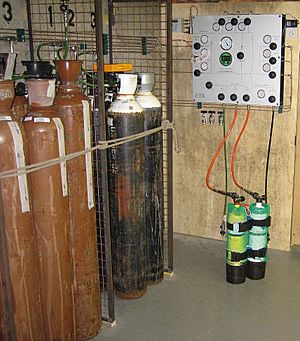Nitrogen narcosis facts for kids
Nitrogen narcosis is a temporary problem that can affect underwater divers. It makes a diver feel confused or dizzy, a bit like being very tired. This feeling goes away quickly when the diver swims up to a shallower depth. It does not cause any lasting harm once the diver is back at a normal depth.
Contents
Who Can Get Nitrogen Narcosis?
Any underwater diver can experience nitrogen narcosis if they go deeper than about 30 meters (100 feet) while breathing regular air. It happens when the amount of nitrogen gas in their breathing mixture becomes too high.
How to Prevent It
Nitrogen narcosis only happens when the pressure of nitrogen gas is high. Divers can prevent it by staying at shallower depths where the pressure is lower. If a diver needs to go deeper, they can use a special breathing gas that has less nitrogen. For example, Helium gas can be used instead of nitrogen in the breathing mix. This allows divers to go deeper before narcosis becomes a problem.
What Happens to the Diver?
When a diver goes deep, more nitrogen gas dissolves into their body, especially affecting their nerve cells. This changes how the brain and nervous system work.
At first, a diver might feel a little confused or dizzy. As they go deeper, the effects become stronger. In very deep water, a diver could even lose consciousness, which is very dangerous underwater.
Why Is It Dangerous?
A diver affected by nitrogen narcosis will react more slowly and might not think clearly. This can be very risky. If an emergency happens, the diver might not be able to solve the problem safely. This is why divers are trained to recognize the signs and deal with them quickly.
What to Do If It Happens
If a diver starts to feel the effects of nitrogen narcosis, the best thing to do is to swim slowly to a shallower depth. The effects usually disappear quickly as the pressure lessens. Sometimes, divers might also switch to a different breathing gas that contains less nitrogen, often a mixture with helium.
Images for kids
-
Illustration of a lipid bilayer, typical of a cell membrane, showing the hydrophilic heads on the outside and hydrophobic tails inside
See also
 In Spanish: Narcosis de nitrógeno para niños
In Spanish: Narcosis de nitrógeno para niños




